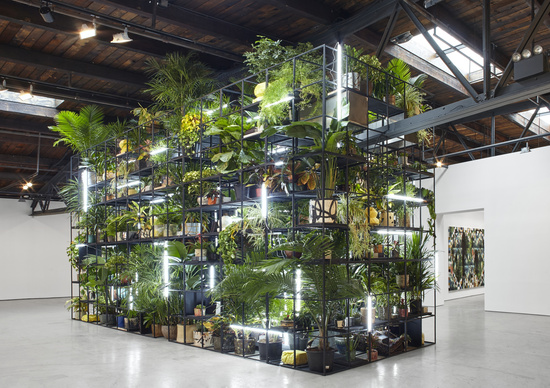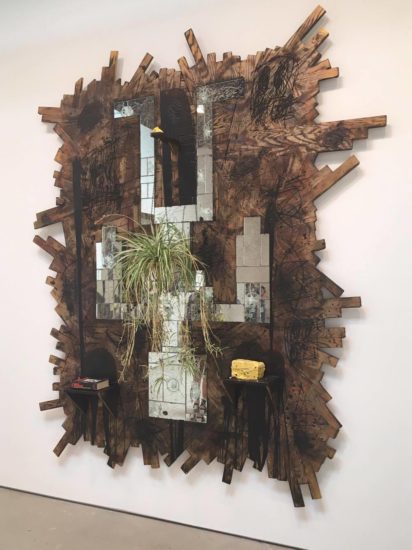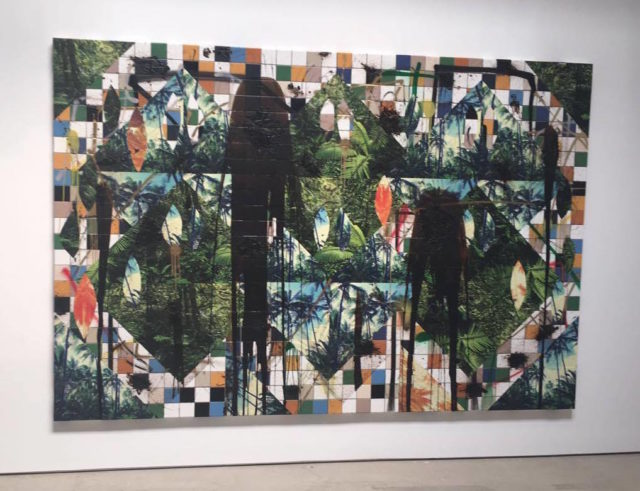
Installation view of Rashid Johnson’s “Antoine’s Organ” from Fly Away at Hauser & Wirth (Photo: Martin Parsekain; Courtesy the artist and Hauser & Wirth)
Rashid Johnson: Fly Away
Hauser & Wirth
511 West 18th Street, New York, NY
On view until October 22, 2016
Sometimes an exhibition articulates our current sociopolitical state so precisely that the advancement of the artist’s work barely matters. Nowhere is this more apparent than in Rashid Johnson’s recently opened solo exhibition Fly Away at Hauser & Wirth.
Fly Away comes at just the right moment with the ever-growing list of names of victims of police violence, reports of mass shootings and ongoing election news. Titled for the frequently covered hymn “I’ll Fly Away,” the show reflects anxiety and fantasy for escape in an era where these feelings seem not only relatable, but unavoidable. It’s so timely it’s haunting.
This relevancy, however, also comes at the cost of any real surprises in the exhibition despite the display of several new series of paintings and a site-specific central installation Antoine’s Organ. The show sees Johnson treading much of the same artistic territory he has in previous exhibitions. Anyone with a passing familiarity with Johnson’s work will recognize much of his symbolically rich, favored materials. They’re all here including shea butter, wood, ceramic tile, plants and, what he terms, “cosmic slop”–a thick mixture of black West African soap and wax.

Rashid Johnson, Untitled Anxious Audience, 2016, white ceramic tile, black soap and wax (photo by author for Art F City)
Not only are the materials familiar, but so is the imagery. Take, for example, Johnson’s Anxious Audiences series, which introduces viewers to the exhibition with a social anxiety disorder fever dream. The six Untitled Anxious Audience paintings, surrounding viewers on all sides, follow the works featured in Johnson’s solo show Anxious Men at The Drawing Center last year. Whereas Anxious Men focused on portrait-sized representations of his frazzled and frantic faces carved from his “cosmic slop” on white tile, Anxious Audience expands these singular faces into entire crowds with rows upon rows of hysterical expressions.
Even Antoine’s Organ–likely the standout piece with an occasional live performance by jazz pianist Antoine Baldwin inside the installation’s structure–is just a larger version of Johnson’s plant and shea butter bust-filled, fluorescent-lit architectural grids. This incarnation features small video monitors playing Johnson’s older video works, as well as stacks of books including Randall Kennedy’s Sellout: The Politics of Racial Betrayal and Richard Wright’s Native Son. Antoine’s Organ and Anxious Audiences’ growth points to what was likely the purpose behind his choice to build on older work. Namely, the challenges of showing in Hauser & Wirth’s enormous hangar-like space. Even art historical icons like Philip Guston couldn’t quite master the former roller disco. Bigger, in this case, is often better, which seems to be Johnson’s reasoning.
While there certainly is a value to an artist reinterpreting their own visual lexicon, I would have liked to see Johnson reach further with his own experimentation, particularly given such a grand forum. And yet, the political relevancy of Johnson’s work far surpasses the restrictions of his safer formal qualities.

Rashid Johnson, Falling Man, 2015, burned red oak flooring, spray enamel, mirror, black soap, wax, shea butter, book, plant (photo by author for Art F City)
This engagement with politics is perhaps most most obvious in his new series Falling Men. Despite their disparate shapes and backgrounds, each painting features a grid of mirrored tiles that form the shape of an upside-down stick figure. The figures are deceptively simple like a child’s drawing. With broken mirrors scattered over the figure like bruises or bullet wounds, the figures look like chalk outlines of corpses at crime scenes. The broken tiles’ resemblance to wounds is further emphasized by a nearby sculpture featuring enormous slabs of shea butter on a Persian rug-covered table. Among numerous other uses of shea butter, shea butter can be used to heal cracked skin, reflecting the ruptures in the Fallen Men paintings.
Admittedly, it is difficult to interpret the Falling Men series outside of the context of police brutality inflicted against people of color. Johnson, during his press preview walkthrough, left the political interpretations up to viewers, but did acknowledge that, as a black male artist, there is always a political aspect of his work. He recalled that his mother taught him early that his body was already inherently political.
It doesn’t seem fair to relegate the understanding of Falling Men or Fly Away to only a representation of the threats against black bodies alone. The contemporary fears and fantasies of Fly Away are more vague and universal as seen in his paintings Escape Collages.

Rashid Johnson, Untitled Escape Collage, 2016, ceramic tile, black soap, wax, vinyl and spray enamel (photo by author for Art F City)
Johnson’s Escape Collages layer colorful tile, tropical imagery and an occasional vintage photograph of Johnson’s father to aestheticize a deep yearning for escape. But, not everything is just palm trees and daiquiris. He splatters his black “cosmic sludge” on top of this exotic landscape, representing a looming sense of dread that lingers from the Anxious Audiences series in the previous room.
The fantasy of escape, particularly for people of color, is frequently loaded with the harsh realities of racism, violence and phobia. This leads to a search for a better elsewhere whether real or imagined. As he articulated in the press preview, this desire for escape follows a long trajectory of Black American cultural objects. Johnson listed examples such as narratives detailing escape from slavery, the Back-To-Africa Movement and legendary musician Sun Ra’s claims he visited Saturn. Even gospel songs, similar to “I’ll Fly Away,” speak of transcendence in the afterlife after struggles on Earth.
And yet, can’t everyone, particularly today, relate to the desire to just sail off to a tropical island? I know I can. While certainly more weighted historically and even, significant socially for viewers of color, Johnson’s Escape Collages offer a form of momentary escape for all viewers regardless of identity. With diamond-shaped holes cut out of the island images, exposing the vibrant tiles, Johnson’s paintings are engrossing and, like Johnson’s best work, transport viewers to a different place and time, however short-lived.


Comments on this entry are closed.